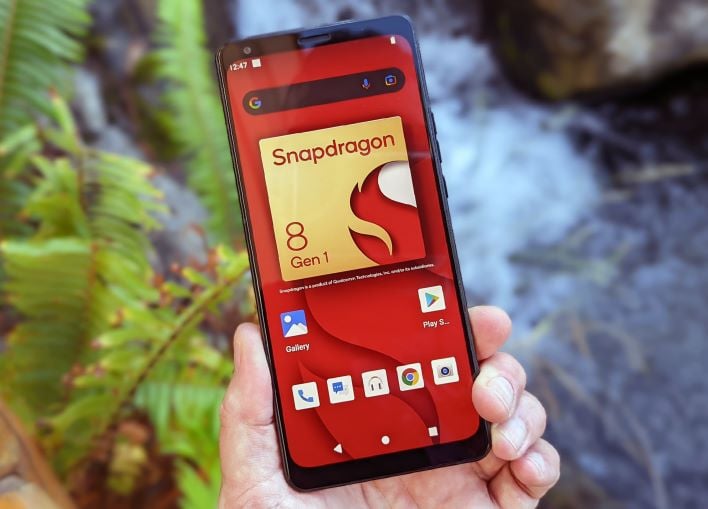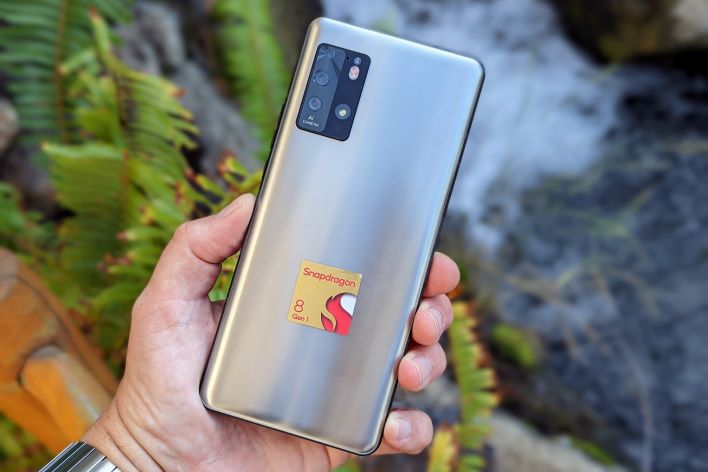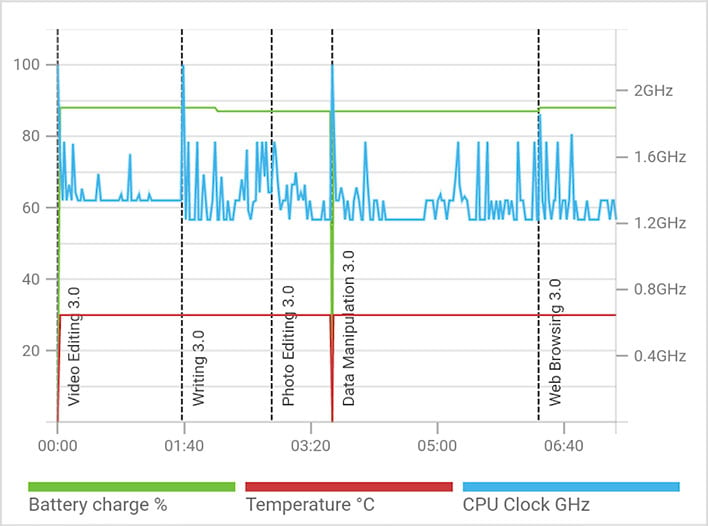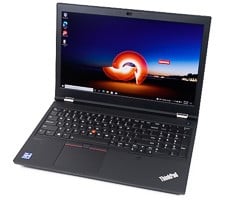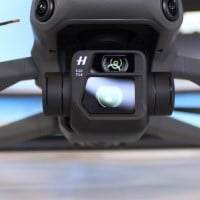Snapdragon 8 Gen 1 Benchmarks: Huge AI And Gaming Gains For Next-Gen Android Flagships
Track Tests With Qualcomm's New Premium Android Phone Platform Show Impressive Results
Qualcomm recently announced a new flagship mobile chipset for next-gen Android devices, the Snapdragon 8 Gen 1, which also kicks off a rebrand of the Snapdragon platform. Going forward, Qualcomm will no longer use three-digit model number designations as it has done with past chipsets like the Snapdragon 888+ 5G. In somewhat vague terms, Qualcomm said it needed a "bigger tent, a longer playing field so to speak," as it aims to broaden the appeal of Snapdragon "while keeping true to its core."
The Snapdragon 8 Gen 1 gets the party started, with Qualcomm kicking off its rebranding effort with a premium tier SoC that will be powering an array of upcoming flagship devices. In terms of its specifications, the Snapdragon 8 Gen 1 is a stout chip, brimming with high-tech features, like a 7th Gen Qualcomm AI engine that purportedly delivers up to four times better AI performance compared to the previous flagship.
The Snapdragon 8 Gen 1 is built on a 4-nanometer manufacturing process an features a Kryo CPU complex that Qualcomm claims is 20 percent faster and 30 percent more power efficient than the last-gen. More specifically, it rocks a 1+3+4 configuration consisting of a single Prime Cortex-X2 core clocked at up to 3.0GHz, three Cortex-A71 Performance cores clocked at up to 2.5GHz, and four Cortex-A51 Efficiency cores clocked at up to 1.8GHz.
As a point of comparison, the Snapdragon 888+ 5G with its Kryo 680 CPU wields a single Cortex-X1 core clocked at up to 3GHz, three Cortex-A78 Performance cores clocked at up to 2.4GHz, and four Cortex-A51 Efficiency cores clocked at up to 1.8GHz.
Interestingly, the Snapdragon 8 Gen 1's upgraded Prime core matches the clock speed of the Snapdragon 888+ rather than the regular Snapdragon 888 (2.84GHz), which is nice to see. It also gets a bump in shared L3 cache (6MB versus 4MB).
Qualcomm's newest flagship also boasts an upgraded Adreno GPU that is purportedly 30 percent faster (or up to 60 percent faster in some Vulkan workloads) and 25 percent more power efficient than the previous generation.
As far as first impressions go, the Snapdragon 8 Gen 1 certainly dazzles from a high-level overview of its spec sheet. It's not just about the CPU and GPU advances, either. As we highlighted in our previous coverage, there is a laundry list of improvements, from AI processing and camera/imaging technologies, to bolstered wireless connectivity.
Snapdragon 8 Gen 1 Performance Test Vehicle
To test performance of the new platform, we managed to get our hands on a prototype handset that is outfitted with the Snapdragon 8 Gen 1, paired to 8GB of LPDDR5 RAM and 512GB of UFS 3.1 storage.
Fortunately for us (and you, the reader) we have an extensive collection of benchmarks from handsets with Qualcomm’s Snapdragon Mobile platform in tow, so we have meaningful data points to see if the Snapdragon 8 Gen 1 is truly primed to rule the next-gen Android flagship space. The only exception, really, is MediaTek's new Dimensity 9000. That is a comparison that will have to wait for another day. Considering MediaTek's lack of 5G mmWave support, though, the Dimensity 9000 isn't likely to make much of a splash in the U.S.
In lieu of that eventual showdown, however, we have plenty of data points from past Snapdragon flagships, as well as the excellent Smartphone For Snapdragon Insiders handset (a joint collaboration between Qualcomm and ASUS), and also Google's recently launched Pixel 6 phones. So, let's get started, shall we?
UL PCMark For Android Work 3.0
PCMark for Android is an excellent suite of tests if you want to benchmark a wide range of tasks on any handset -- things like image and video editing, as well as lighter-duty, everyday workloads such as email and web browsing. When you see the test running live, it's clear the scripted application tests are carefully selected and tuned to make use of the each mobile platform in a very controlled way...
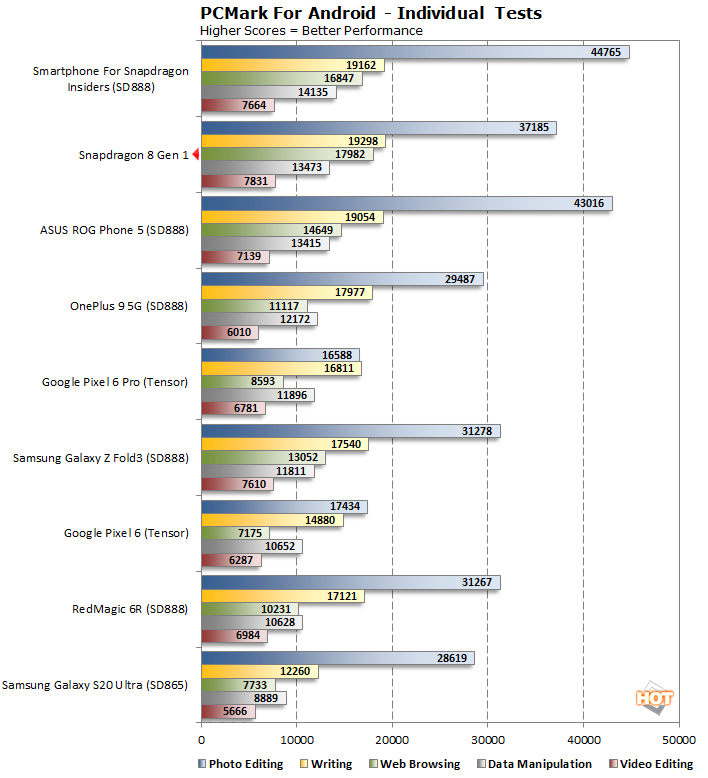
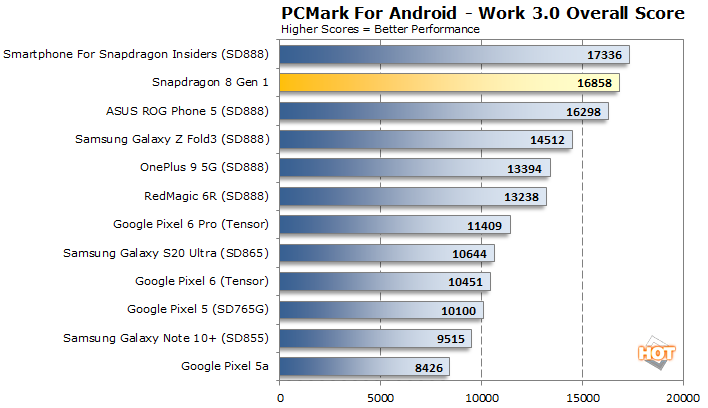
Right out of the gate, the Snapdragon 8 Gen 1 takes a second-place finish behind the aforementioned Smartphone For Snapdragon Insiders. That's a little surprising, given that the Smartphone For Snapdragon Insiders touts a regular Snapdragon 888 chipset instead of the Plus variant (albeit the handset is highly tuned).
Looking at the individual tests, the Snapdragon 8 Gen 1 notched victories in Writing, Web Browsing, and Video Editing, while trailing in Data Manipulation and especially Photo Editing, where it lost by wide margins to the Smartphone For Snapdragon Insiders and ASUS ROG Phone 5. This is likely due to early firmware for storage access, especially considering how much PCMark favors storage performance.
If we tunnel even deeper into the hardware health date for PCMark, it gives us an additional glimpse into the Snapdragon 8 Gen 1's performance. In all of the tests, the chip quickly ramps up to its peak temperature target, which commensurately pulls down clock speeds. In each test, the Snapdragon 8 Gen 1 initially starts at a frequency in excess of 2GHz, but almost immediately ramps down and ultimately hovers in the 1.2GHz to 1.7GHz range, with plenty of peaks and valleys.
As you look at this data, keep in mind, we are testing an prototype vehicle, that is not fully optimized. The frequency and voltage curve of the Snapdragon 8 Gen 1 in retail ready devices may differ somewhat to what you see here, depending on the cooling capabilities, battery, and what the OEM deems is an acceptable skin temperature of its device.
Geekbench 5 Benchmarks
Geekbench is a cross-platform benchmark that simulates real world processing workloads in image processing and particle physics calculation scenarios. We tested all of the smartphones featured here with Geekbench's single and multi-core workloads.

The results in Geekbench 5 were more to our expectations. Looking at the top Android phones over the past year or so, most have scored in the neighborhood of 1,120 for the single-core test, with the ROG Phone 5 in X-Mode leading the way with a score of 1,229. That is, until now—the Snapdragon 8 Gen 1 scored 9.21 percent higher in the single-core test to move into pole position. That's respectable, though not really a beat-down.
It also led the Android pack in the multi-core test with a score of 3,740. It's not a crushing victory, but it still came out ahead of every other Android phone we've tested to date. Apple, however, still maintains a sizable lead here with its latest devices.
AnTuTu And AITuTu Benchmarks
AnTuTu’s latest benchmark returns a number of metrics ranked with somewhat nebulous scores, rather than frame rates or time to complete. Here we're running the latest version of AnTuTu across multiple Android devices. AnTuTu returns four top level performance results which are all included here: CPU, RAM, 3D, UX (or User Experience), along with a total score...
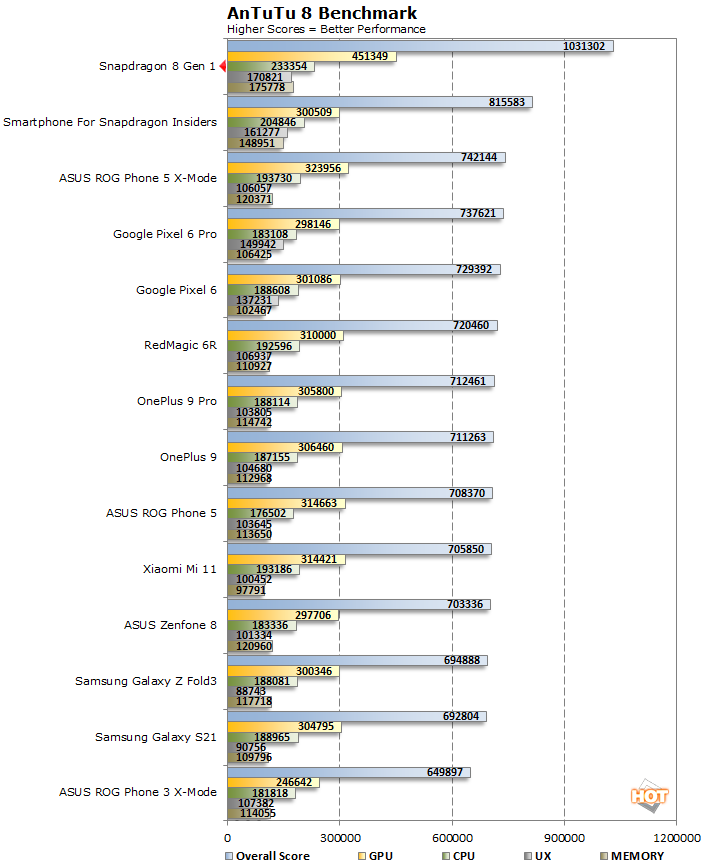
The Snapdragon 8 Gen 1 really hit its stride in AnTuTu 8 where it flexed a greater than 26 percent victory over the Smartphone For Snapdragon Insiders, and an almost 40 percent gain over the ROG Phone 5 (in X-Mode, no less) and Pixel 6 Pro with its Tensor core foundation.
Even more impressive is the individual GPU score—the Snapdragon 8 Gen 1 outpaced the Smartphone For Snapdragon by more than 50 percent.
AITuTu evaluates the AI performance of a device by leveraging two mainstream neural network models for machine learning and AI -- Inception v3 for Image Classification and MobileNet-SSD for Object Detection. The benchmark determines the device’s accuracy and speed when inferring data from each workload.
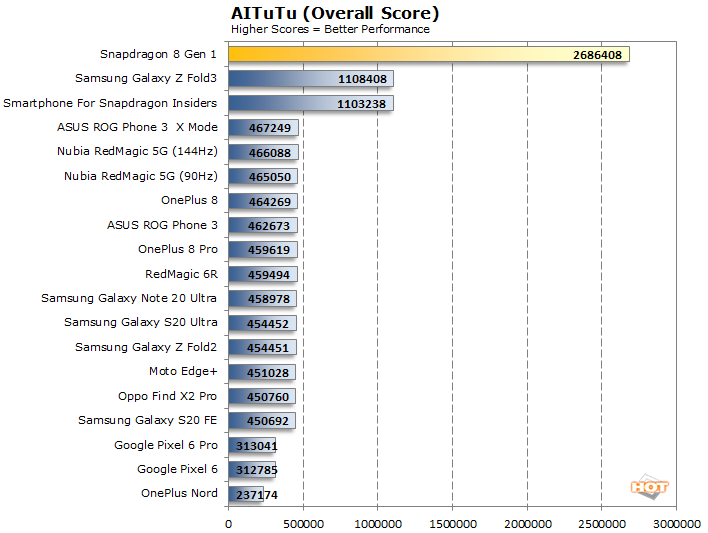
One of the claims Qualcomm made during its Snapdragon Tech Summit event is that the Snapdragon 8 Gen 1 sports the fastest-ever artificial intelligence engine, with quadruple the performance of its predecessors. That's obviously going to depend on the specific application and workload. However, it's safe to say the Snapdragon 8 Gen 1 offers a massive leap in AI performance, based on our benchmark data.
Up until now, the Galaxy Z Fold3 and Smartphone For Snapdragon Insiders boasted the best AITuTu scores, and by wide margins. The Snapdragon 8 Gen 1, however, whipped them both by more than 142 percent. That is nothing short of impressive, and it bodes well for the chipset's 7th Gen AI engine that Qualcomm speaks so highly of.
Browser Benchmarks: Speedometer 2
Next up, we have some numbers from the Speedometer 2.0 test available at browserbench.org. The Speedometer Benchmark Suite uses a wide array of latency and throughput benchmarks to evaluate web application performance. This benchmark measures performance of an array of browser-based technologies used on modern, rich web applications. Scores in these benchmark are an indicator of the performance users would see when browsing the web and running advanced web apps.

Gaming And Graphics Benchmarks
Next we're going to see how the Snapdragon 8 Gen 1 compares to some other devices in GFXBench, which has been one of the standard mobile graphics/gaming performance benchmarks for years. To ensure that display refresh (v-sync) and resolution aren't limiting factors, we're comparing off-screen test results here. GFXBench tests OpenGL ES graphics workloads...
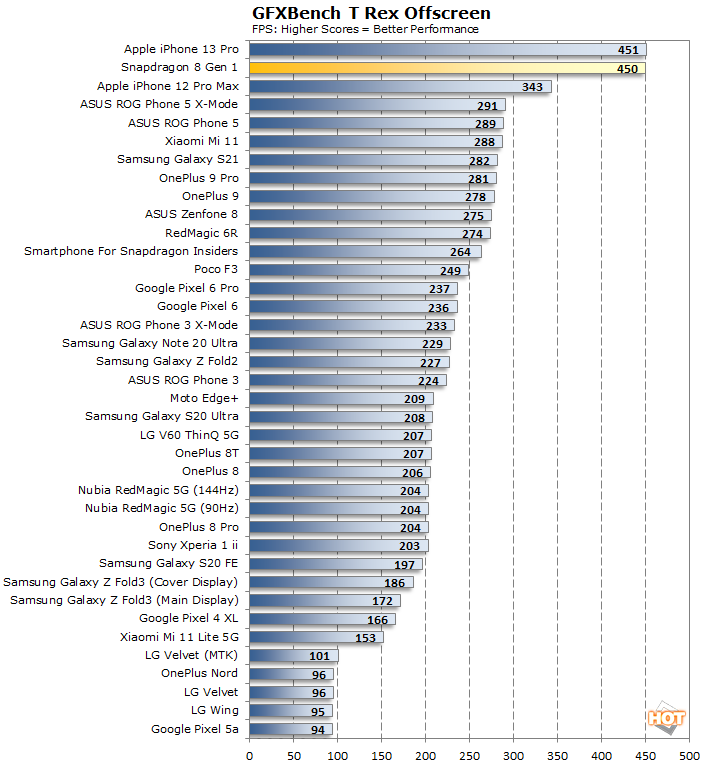

3DMark Sling Shot is a newer benchmark module that's been added to the 3DMark mobile suite. Unlike previous gen 3DMark mobile tests, Sling Shot is a more advanced OpenGL ES 3.1 and Metal API-based benchmark that employs more advanced rendering techniques, like volumetric lighting, particle illumination, multiple render targets, instanced rendering, uniform buffers and transform feedback. We're running this test in off-screen mode once again to remove display resolution differences from the equation. This lets us compare cross-platform results more reliably...

3DMark Sling Shot Extreme Benchmark
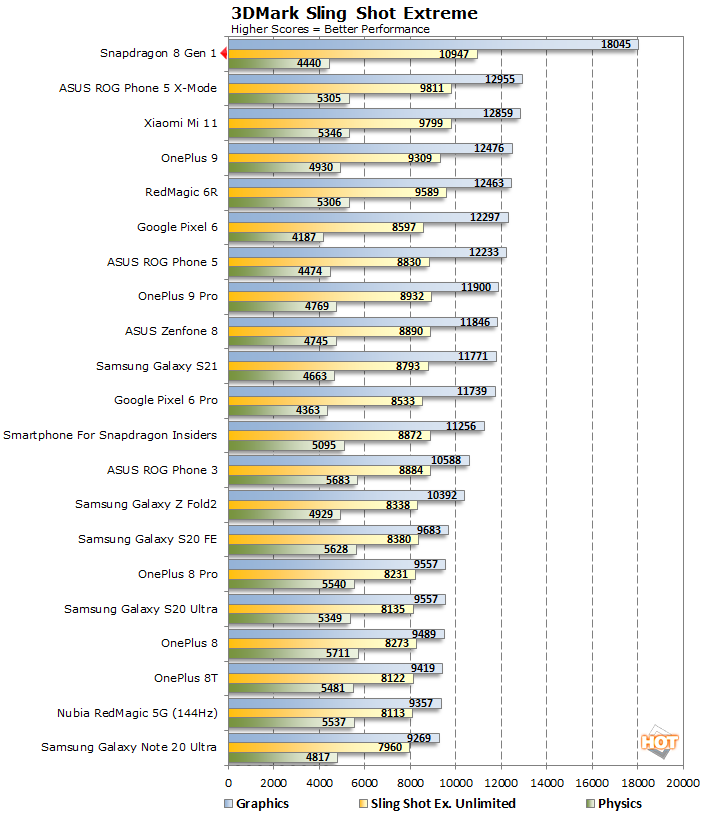
Although the Snapdragon 8 Gen 1's Physics score in this benchmark is somewhat middling in light of some of the faster Android-based devices we tested, it still manages to jump out to a massive lead in the overall score thanks to particularly strong graphics performance.
3DMark Wild Life is the latest cross-platform graphics test from UL. UL explains that WildLife is primarily tasked with measuring GPU performance across platforms, and two distinct tests are available. The standard WildLife test is designed to give feedback on how a game performs over a short period of time. With mobile games, people typically play in brief spurts when they find some free time; be it on the bus, on the subway, or a quick battle royale session on your lunch break. The 3DMark WildLife Stress Test, on the other hand, shows how a device performs over a longer stretch of time, and takes note of performance degradation that can crop up due to increased heat levels and throttling (which we'll get to a bit later).

3DMark Wild Life Extreme Benchmark

The Snapdragon 8 Gen 1 clearly outran all of the other Android-based devices in 3DMark's latest Wildlife benchmark as well, besting the Google Pixel 6 by over 44%. The Snapdragon 8 Gen 1 also beats every iPhone except for the top-end iPhone 13 Pro which finishes about 12% ahead.
Snapdragon 8 Gen 1 Preliminary Performance Conclusions
Summed up, the Snapdragon 8 Gen 1 is looking quite stout in the early going. It's important to note that early performance previews lack the benefit of polished firmware and drivers, which can often make a significant difference. Even so, Qualcomm's latest SoC is off to a strong start, with the Snapdragon 8 Gen 1 looking formidable in most tests, especially in relation to graphics.
That's good news for mobile gamers. From what we have witnessed so far, the upgraded Adreno GPU delivers a huge performance uplift over the previous generation, and that in turn will keep manufacturers motivated to push the envelope with hardware designed with gamers in mind. It also helps cement Android as a viable gaming platform. This is an area Qualcomm is very much interested in pursuing, as also evidenced by its partnership with Razer on its Snapdragon G3x Gen 1 platform and handheld dev kit.
We saw exceptionally strong gains in AI performance, too. This is an aspect of the mobile experience that consumers may sometimes take for granted, but one that plays an important role. From camera and imaging capabilities, to digital assistants and clever security features, AI's role is constantly expanding and evolving. At first glance, it appears the Snapdragon 8 Gen 1 offers device makers and developers a lot more power to leverage for AI chores.
Qualcomm's latest flagship chip also brings gains in CPU performance, though from what we have seen so far, they are not as pronounced as they are in graphics and AI. Or at least that's the case in Geekbench 5, where the Snapdragon 888 came within striking distance of the Snapdragon 8 Gen 1.
It's still early though, and it is conceivable that Snapdragon 8 Gen 1 will showcase bigger compute gains when it ships in actual devices. Time will tell. From what we have seen so far, though, Snapdragon 8 Gen 1 is an overall impressive upgrade in the flagship space. Qualcomm already has a bunch of OEMs and brands lined up (like Motorola, Razer, Sharp, Sony, and others) and says commercial devices should ship by the end of 2021.

